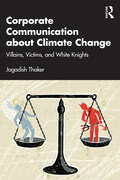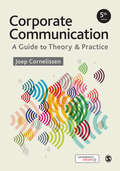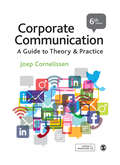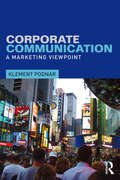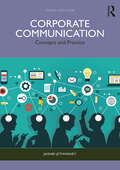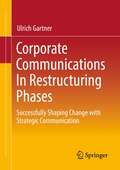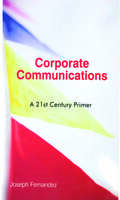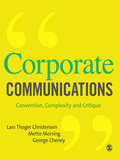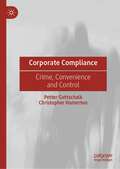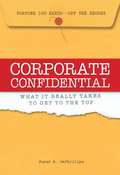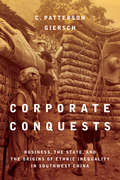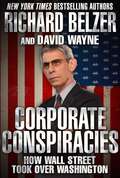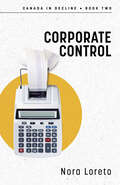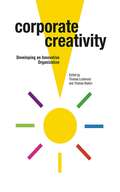- Table View
- List View
Corporate Communication a Guide to Theory and Practice
by Joep Cornelissen`This is a comprehensive and scholarly analysis of corporate communications. It will offer students and practitioners alike a considerable aid to study and understanding which will stand the test of time in a fast changing business' - Ian Wright, Corporate Relations Director, Diageo Incorporating current thinking and developments in the field from both the academic and practitioner worlds, the Second Edition of this bestseller combines a comprehensive theoretical foundation with numerous practical examples. The Second Edition features: - New chapters on stakeholder management and communication, corporate identity, image and reputation, internal communications and change, media and investor relations and issues in crisis management - New case vignettes and cases of corporate communications in US and European companies - An integrated case (Toyota) at the end of the text connecting all the different themes of the book. Praise for the First Edition: `A welcome and important addition to the limited writing already available on corporate communication. The book focuses correctly on the strategic management perspective necessary for an understanding of this area. It will be of enormous help to practitioners and academics in their quest to understand what may well be the most important functional area for most corporations in the coming years' - Paul A Argenti, Professor of Management and Corporate Communication, The Tuck School of Business at Dartmouth, USA `This is the text that practitioners, academics, and students in corporate communications have been waiting for. The book is accessible, comprehensive and is well balanced in discussing both theoretical and practical perspectives upon corporate communications. It is simply a must-read for those who want to be at the cutting edge of corporate communications' - Phil Harris, Professor of Marketing, University of Otago and International Director of the European Centre for Public Affairs in Brussels
Corporate Communication about Climate Change: Villains, Victims, and White Knights
by Jagadish ThakerEmbedded in the emerging field of climate change communication, Thaker provides a comprehensive analysis of enablers and barriers to corporate action on climate change, business role and influence on media coverage of climate change, and its impact on public opinion and the policy-making process.Focusing on extensive academic research, business reports, case studies, and best practices from around the world, this book offers a practical guide to effective strategies in corporate climate change communication, including leadership communication, rebuilding public trust amidst greenwashing scandals, and engaging stakeholders with business action on climate change. The book provides new directions on the role of social media influencers, artificial intelligence, and big data in enhancing transparency in business actions and effective communication with key stakeholders.This book is an essential read for students, scholars, and professionals interested in the emerging fields of climate change communication, strategic communication, and related areas of sustainability and Environmental, Social, and Corporate Governance (ESG) communication.
Corporate Communication: A Guide to Theory and Practice
by Joep P. CornelissenThis popular, market-leading textbook for corporate communication continues to be the authoritative and definitive textbook for students and educators. The text has been fully updated to include: • changes to the workplace in light of the Covid-19 pandemic and its impacts on employee communication via platforms such as Zoom and Microsoft Teams • the ongoing impacts of digital disruption and transformation on corporate communication at the advent of the ‘metaverse’ and alongside consideration of popular newer social media such as TikTok • the increasing focus on sustainability and the United Nations’ Sustainable Development Goals (SDGs); societal impact, purpose and corporate social responsibility; and the importance of social justice and inclusion within organizations and how these relate to organizational communication New case studies include Black Lives Matter (Starbucks); surveillance capitalism (Facebook); diversity and inclusion (Microsoft); and hybrid working (British Airways). This textbook is essential reading for communication courses including: corporate communication; organizational communication; management communication; strategic communication; and public relations. Joep Cornelissen is Professor of Corporate Communication and Management at Rotterdam School of Management, Erasmus University.
Corporate Communication: A Guide to Theory and Practice
by Joep P. CornelissenThis popular, market-leading textbook for corporate communication continues to be the authoritative and definitive textbook for students and educators. The text has been fully updated to include: • changes to the workplace in light of the Covid-19 pandemic and its impacts on employee communication via platforms such as Zoom and Microsoft Teams • the ongoing impacts of digital disruption and transformation on corporate communication at the advent of the ‘metaverse’ and alongside consideration of popular newer social media such as TikTok • the increasing focus on sustainability and the United Nations’ Sustainable Development Goals (SDGs); societal impact, purpose and corporate social responsibility; and the importance of social justice and inclusion within organizations and how these relate to organizational communication New case studies include Black Lives Matter (Starbucks); surveillance capitalism (Facebook); diversity and inclusion (Microsoft); and hybrid working (British Airways). This textbook is essential reading for communication courses including: corporate communication; organizational communication; management communication; strategic communication; and public relations. Joep Cornelissen is Professor of Corporate Communication and Management at Rotterdam School of Management, Erasmus University.
Corporate Communication: A Guide to Theory and Practice
by Professor Joep P. CornelissenUsed by nearly 25,000 students in over 50 countries, this book incorporates current thinking and developments on corporate communication from both the academic and practitioner worlds. Combining a comprehensive theoretical foundation with numerous practical guidelines, insights will assist managers (or soon to be managers) in their day-to-day work and in their strategic and tactical communication decisions. With cases and examples from across the globe including Apple, BMW, Uber, L’Oréal and Starbucks, the new edition is updated to include more material on social media, employee communication, leadership communication and anti-corporate activism. The Fifth Edition of Corporate Communication is supported by a Companion Website and includes Full text SAGE journal articles, glossary, web links for each chapter, author-selected videos relevant to the key themes and hot topics, an authors’ blog and author videos for students as well as case study notes, PowerPoint slides, and additional case studies for lecturers. Suitable for students at advanced undergraduate and postgraduate levels on business management, marketing, corporate communication, public relations or business communications programmes as well as practitioners in the field.
Corporate Communication: A Guide to Theory and Practice
by Professor Joep P. CornelissenUsed by nearly 25,000 students in over 50 countries, this book incorporates current thinking and developments on corporate communication from both the academic and practitioner worlds. Combining a comprehensive theoretical foundation with numerous practical guidelines, insights will assist managers (or soon to be managers) in their day-to-day work and in their strategic and tactical communication decisions. With cases and examples from across the globe including Apple, BMW, Uber, L’Oréal and Starbucks, the new edition is updated to include more material on social media, employee communication, leadership communication and anti-corporate activism. The Fifth Edition of Corporate Communication is supported by a Companion Website and includes Full text SAGE journal articles, glossary, web links for each chapter, author-selected videos relevant to the key themes and hot topics, an authors’ blog and author videos for students as well as case study notes, PowerPoint slides, and additional case studies for lecturers. Suitable for students at advanced undergraduate and postgraduate levels on business management, marketing, corporate communication, public relations or business communications programmes as well as practitioners in the field.
Corporate Communication: A Guide to Theory and Practice
by Professor Joep P. CornelissenThe Sixth Edition of Corporate Communication: A Guide to Theory and Practice? continues to be the market leading text in its field, having been fully revised by the author to reflect new trends and developments in social media and to capture emergent topics such as CEO activism and corporate character and purpose. New to This Edition: A revised chapter on comm's in the rapidly changing media landscape, incorporating new technologies and social media. Deeper coverage of key topics such as employee, crisis, and leadership communication alongside sustainability. New case studies with reflective questions to highlight the broad application of corporate communications. Corporations featured include: Apple, Facebook, Gilette, Lenovo and Nestlé. Corporate Communication is essential reading for students studying Corporate Communication, Organizational Communication, Strategic Communication, PR and Marketing Communications, as well as a valuable resource for reflective practitioners. It continues to be supported by comprehensive and fully updated online resources.
Corporate Communication: A Guide to Theory and Practice
by Professor Joep P. CornelissenThe Sixth Edition of Corporate Communication: A Guide to Theory and Practice? continues to be the market leading text in its field, having been fully revised by the author to reflect new trends and developments in social media and to capture emergent topics such as CEO activism and corporate character and purpose. New to This Edition: A revised chapter on comm's in the rapidly changing media landscape, incorporating new technologies and social media. Deeper coverage of key topics such as employee, crisis, and leadership communication alongside sustainability. New case studies with reflective questions to highlight the broad application of corporate communications. Corporations featured include: Apple, Facebook, Gilette, Lenovo and Nestlé. Corporate Communication is essential reading for students studying Corporate Communication, Organizational Communication, Strategic Communication, PR and Marketing Communications, as well as a valuable resource for reflective practitioners. It continues to be supported by comprehensive and fully updated online resources.
Corporate Communication: A Marketing Viewpoint
by Klement PodnarCorporate Communication: A Marketing Viewpoint offers an overview of the framework, key concepts, strategies and techniques from a unique marketing perspective. While other textbooks are limited to a managerial or PR perspective, this book provides a complete, holistic overview of the many ways communication can add value to an organization. Step by step, this text introduces the main concepts of the field, including discipline and function frameworks, corporate identity, corporate and employer branding, corporate social responsibility, stakeholder management, storytelling, corporate associations, identification, commitment and acceptability. In order to help reinforce key learning points, grasp the essential facts and digest and retain information, the text offers a comprehensive pedagogy, including: chapter summaries; a list of key words and concepts; case studies and questions at the end of each chapter. Principles are illustrated through a wealth of real life examples, drawn from a variety of big, small, global and local companies such as BMW Group, Hidria, Lego, Mercator, Krka, Barilla, Domino's Pizza, Gorenje, Si Mobil, BP, Harley-Davidson and Coca-Cola. This exciting new textbook is essential reading for all professional corporate marketing and communication executives, as well as undergraduate and postgraduate students of marketing and public relations, not to mention managers who need a complete and accurate view of this increasingly important subject.
Corporate Communication: Concepts and Practice
by Jaishri JethwaneyCorporate Communication: Concepts and Practice—a comprehensive and engaging textbook—helps in understanding the underlying concepts and real-life strategies of communication in modern-day corporate set-ups. One of the youngest management disciplines, corporate communication is used by companies to position themselves to the outside world in a highly competitive business environment and to build a “sense of being,” on the one hand, and creating a feeling of pride in being associated with the company for various stakeholders, especially the employees and investors. Some of the functions of corporate communication include identifying and segmenting stakeholders, articulating brand positioning, selecting appropriate channels of internal and external communication, and managing crises, conflicts, and reputations, among others. This revised edition offers a fresh perspective into all basic and critical aspects of corporate communication and incorporates the latest changes in governmental policies and industry trends to aid students adapt to the contemporary business environment and become industry-ready. This book will be of great interest to students and researchers working in the areas of corporate communication, organizational communication, journalism, mass communication, communication studies, public relations, and human resource management.
Corporate Communications In Restructuring Phases: Successfully shaping change with strategic communication
by Ulrich GartnerThis book provides those responsible in communication, management and human resources with a practical guide for professional internal and external communication of restructuring programs in companies. From cost-cutting measures to downsizing to the closure of entire locations: changing economic framework conditions and the associated changes are not only an operational challenge, they also require intelligent communication. If this fails, long-term costs through collateral damage such as declining employee motivation or loss of reputation can wipe out the short-term savings.This book shows in a compact way how you can identify key stakeholders, define communicative goals and develop the infrastructure, content and instruments with which you can strategically achieve these goals.The author gives concrete tips, describes concrete procedures and asks targeted questions for success in difficult times.
Corporate Communications: A 21st Century Primer (Response Books)
by Joseph FernandezThis lucid book is a compelling introduction to corporate communications and its practical application in the modern organization. Joseph Fernandez makes a case for corporate communications as the cornerstone of any corporate growth strategy. He does this by highlighting communication approaches drawn from the worlds of advertising, journalism and public relations. Among the topics discussed are: - The evolution and nature of the new era and its unique communication needs. - The role of advertising and public relations as potent tools to build corporate brands and nurture them in global environments. - The advantages of the complementary use of traditional and new media in reaching the entire targeted audience. - The importance of subscribing to healthy corporate citizenship practices for both businesses and non-profit outfits.
Corporate Communications: Convention, Complexity and Critique
by Mette Morsing Dr George E. Cheney Dr Lars T. ChristensenThe field of corporate communications describes the practices organizations use to communicate as coherent corporate `bodies'. Drawing on the metaphor of the body and on a variety of theories and disciplines the text challenges the idealized notion that organizations can and should communicate as unified wholes. The authors pose important questions such as: - Where does the central idea of corporate communications come from? - What are the underlying assumptions of most corporate communications practices? - What are the organizational and ethical challenges of attempting truly `corporate' communication? Clearly written with international vignettes and executive briefings, this book shows that in a complex world the management of communication needs to embrace multiple opinions and voices. Rewarding readers with a deeper understanding of corporate communications, the text will be a `must read' for advanced undergraduates, graduate students, and scholars, in the arenas of corporate communications, organizational communication, employee relations, marketing, public relations and corporate identity management. Practitioners in these areas will be provoked to re-examine their assumptions and habits.
Corporate Community Involvement: A Visible Face of CSR in Practice (Corporate Social Responsibility)
by Bilge Uyan-AtayThere has been tremendous growth in Corporate Community Involvement (CCI) projects of all sizes in recent years. This has been encouraged by organisations such as Business in the Community in the UK, which provides information designed to motivate businesses and government to engage in CCI. In fact, the projects incorporated into some companies’ strategy implementation are now so extensive that they are having a profound impact on community development. Corporate Community Involvement examines CCI as a distinct type of corporate social responsibility and the nature of the relationship between business and society. Bilge Uyan-Atay considers that CCI has been poorly described and researched, concentrating mainly on Western Europe and the USA, failing to consider different institutional contexts and to make the best use of available theory to uncover a more holistic perspective. The author’s native Turkey is a secular, developing country with a growing economy. This provides a distinctive environment in which to study CCI. The author explores and analyses economic, strategic, cultural and institutional influences on CCI and its relationships to and differences from corporate social responsibility.
Corporate Community Involvement: The Definitive Guide to Maximizing Your Business' Societal Engagement
by Nick Lakin Veronica Scheubel"We need to do Community Involvement better – we know we're spending millions each year on charitable causes; how can we find out what is really effective and what people will appreciate us for? Who should we partner with? How can we make a real difference in society and help our business?" Companies around the world are trying to answer these questions. Many are asking the same questions even as, collectively, they continue to spend billions on their communities. How do they know which activities are really worthwhile? Building on the authors' own extensive global experience at Nokia and E.ON, as well as the experience of many other experts in the field, this book offers the first-ever "how to" roadmap for managers on the comprehensive implementation of strategic Community Involvement inside their companies. It is designed to be practical, for those who want to act upon what they have read. It will fill a long-neglected niche as a day-to-day reference guide for practitioners. Corporate Community Involvement demonstrates what to do and how to do it. The advice is backed up by inspiring interviews with best-in-class practitioners from businesses such as Microsoft, GlaxoSmithKline, Ericsson, and Deutsche Bank and leading international Corporate Responsibility and Community Involvement experts. The book highlights proven best-practice approaches, effective methods, and concise tools to help managers "get there faster" and "get it right first time." The core of the book is a step-by-step guide to developing and implementing a comprehensive and successful approach to Corporate Community Involvement. It shows how to: conduct a current state analysis and devise a strategy, organize staffing and budgets, integrate Corporate Community Involvement throughout the business and create high-profile programs, partner across sectors, measure and evaluate results, communicate successful activities, and overcome challenges. Corporate Community Involvement has an international perspective: the models and principles advocated are adaptable anywhere in the world. Also, it is designed to have as much relevance to a small or medium-sized enterprise as to a multinational. The book outlines the history and future of Corporate Community Involvement, explaining the business context and why companies need to manage their programs strategically. It also distinguishes between the growing lexicon of terminologies and provides clear definitions of terms such as "philanthropy", "sponsorship", "Corporate Citizenship", "Corporate Responsibility" and "Sustainability", advising when they are appropriate and how each can add value to corporate activities. This will be an indispensible resource for those working at the interface between business and the community. New or developing practitioners will learn from both the successes and failures of those before them. Representatives from other sectors, notably government, international agencies, NGOs, and academia, will come to understand companies' internal requirements for cross-sector collaboration programs in the community better. And students interested in this field will be better equipped to start careers.
Corporate Compliance and Conformity: A Convenience Theory Approach to Executive Deviance (Routledge Advances in Management and Business Studies)
by Petter GottschalkTraditionally, control in organizations is concerned with top-down approaches, where executives attempt to direct their employees’ attention, behaviors, and performance to align with the organization’s goals and objectives. This book takes a new approach by turning the problem of control upside down as it focuses on control of executives who find white-collar crime convenient. The bottom-up approach to executive compliance focuses on organizational measures to make white-collar crime less convenient for potential offenders. Rather than focusing on the regulatory formalities and staged procedures of compliance and audits, the book emphasizes the organizational challenges involved in compliance work when trusted corporate officials exhibit deviant behavior, refining, and advancing knowledge in this field by reference to contemporary international case studies and associated original evaluative research. The themes and cases covered are carefully selected to provide the reader with an insight into professional conduct and procedural practice – the organization of corporate compliance success, failure, and corruption – with the theory of convenience placed at the fore. It is the bottom-up approach by application of convenience theory that makes the proposed book unique compared to other books on corporate compliance. This book is a valuable resource for scholars and upper-level students researching and studying in the areas of business administration, organizational behavior, corporate and white-collar crime, as well as business ethics and auditing.
Corporate Compliance: Crime, Convenience and Control
by Petter Gottschalk Christopher HamertonCompliance has long been identified by scholars of white-collar crime as a key strategic control device in the regulation of corporations and complex organisations. Nevertheless, this essential process has been largely ignored within criminology as a specific subject for close scrutiny – Corporate Compliance: Crime, Convenience and Control seeks to address this anomaly. This initiating book applies the theory of convenience to provide criminological insight into the enduring self-regulatory phenomenon of corporate compliance. Convenience theory suggests that compliance is challenged when the corporation has a strong financial motive for illegitimate profits, ample organisational opportunities to commit and conceal wrongdoing, and executive willingness for deviant behaviour. Focusing on white-collar deviance and crime within corporations, the book argues that lack of compliance is recurrently a matter of deviant behaviour by senior executives within organisations who abuse their privileged positions to commission, commit and conceal financial crime.
Corporate Confidential
by Susan A. DephillipsObtaining advancement in corporate America is not always nice, fair, or easy. In today's climate of economic uncertainty, you need every ounce of leverage to improve your career standing and potential. The harsh reality: If you're not constantly moving forward, you're losing professional ground-and more aggressive colleagues won't hesitate to poach your position, projects, and opportunities.
Corporate Confidential
by Susan A. DephillipsCorporate Confidential is an honest look at the unspoken truths surrounding success and failure in corporate America. Fifty senior-level executives disclose the candid realities of reaching the executive suite, including how: Refusing to play politics is professional suicide; Pursuing work/life balance will label you as a "B" player; Women unknowingly continue to sabotage their success; and more. So controversial that some executives would only participate on the promise of anonymity, Corporate Confidential provides simple, candid answers on what it really takes to achieve success in today's corporate world.
Corporate Confidential: Fortune 500 Executives Off the Record - What It Really Takes to Get to the Top
by Susan A DephillipsA Simon & Schuster eBook. Simon & Schuster has a great book for every reader.
Corporate Conquests: Business, the State, and the Origins of Ethnic Inequality in Southwest China
by C. Patterson GierschTenacious patterns of ethnic and economic inequality persist in the rural, largely minority regions of China's north- and southwest. Such inequality is commonly attributed to geography, access to resources, and recent political developments. In Corporate Conquests, C. Patterson Giersch provides a desperately-needed challenge to these conventional understandings by tracing the disempowerment of minority communities to the very beginnings of China's modern development. Focusing on the emergence of private and state corporations in Yunnan Province during the late 1800s and early 1900s, the book reveals how entrepreneurs centralized corporate power even as they expanded their businesses throughout the Southwest and into Tibet, Southeast Asia, and eastern China. Bringing wealth and cosmopolitan lifestyles to their hometowns, the merchant-owners also gained greater access to commodities at the expense of the Southwest's many indigenous minority communities. Meanwhile, new concepts of development shaped the creation of state-run corporations, which further concentrated resources in the hands of outsiders. The book reveals how important new ideas and structures of power, now central to the Communist Party's repertoire of rule and oppression, were forged, not along China's east coast, but along the nation's internal borderlands. It is a must-read for anyone wishing to learn about China's unique state capitalism and its contribution to inequality.
Corporate Conservatives Go to War: How the National Association of Manufacturers Planned to Restore American Free Enterprise, 1939–1948 (Palgrave Studies in American Economic History)
by Charlie WhithamWorld War II presented a unique opportunity for American business to improve its reputation after years of censure for inflicting the Great Depression upon the nation. No employers’ organization worked harder or devoted greater resources to reviving business prestige during the war than the National Association of Manufacturers, which spent millions of dollars on promoting the indispensability of private enterprise to the successful mobilization of the American economy in an uncompromising multi-media campaign which spanned the factory floor to the movie theatre. Now, using unpublished primary sources, the full extent of the NAM’s wartime mission to raise the stature of American business in the post-war era is revealed. During the war the NAM erected a vast structure of research on an unprecedented scale numbering more than one hundred persons dedicated to planning the best solutions for restoring American ‘free enterprise’ capitalism after the war in a direct challenge to the ‘liberal’ prescriptions of the reigning administration. These studies were painstakingly assembled and widely distributed and served as a complimentary arm to the better-known pro-business propaganda message of the organization. What emerges is a unique and telling glimpse into the minds of the corporate class of wartime America that reveals the determination of a major employers’ organization to exploit the exceptional circumstances of total war to influence both the power-brokers in Washington who wrote economic policy and the American public as a whole to embrace a post-war future ruled by private enterprise capitalism.
Corporate Conspiracies: How Wall Street Took Over Washington
by Richard Belzer David WayneFrom New York Times bestselling authors Richard Belzer and David Wayne comes a hard look at the wrongs done to us all by big business in America. Here is an explosive account of wrongful acts perpetrated, and the ensuing cover-ups inflicted upon us, by American corporations. The bestselling author team of Richard Belzer and David Wayne exposes the ways that the capitalist regime has got us under their thumbs—from the mainstream media and its control over us, to the trillions stolen by big banks and mortgage companies during the mortgage crisis, to the scams perpetrated by Big Oil and Big Pharma. The one common victim of all that corruption is the American public, and Corporate Conspiracies wants to do something about it.Corporate Conspiracies takes dead aim at those who take advantage of us little guys. Probably most disturbing is the book's examination of politics and capitalism teaming up against us—how politicians and lobbyists all have their hands in each other's pockets while stabbing us in the back, and how the well-established energy lobby—which is petroleum, natural gas, and coal—has played a dominant role in the shaping of US foreign policy for decades. Did you know that companies at times know that their products will kill people, but they do nothing, because it is actually cheaper to compensate the victims than it is to correct the problem? And did you know that the Pentagon is sending $1.5 trillion of our tax dollars to their corporate buddies for a new fighter jet that is already superfluous? This book is guaranteed to make us all think twice about being enslaved and cheated by corporate America. Skyhorse Publishing, as well as our Arcade imprint, are proud to publish a broad range of books for readers interested in history—books about World War II, the Third Reich, Hitler and his henchmen, the JFK assassination, conspiracies, the American Civil War, the American Revolution, gladiators, Vikings, ancient Rome, medieval times, the old West, and much more. While not every title we publish becomes a New York Times–bestseller or a national bestseller, we are committed to books on subjects that are sometimes overlooked and to authors whose work might not otherwise find a home.
Corporate Control: Canada in Decline Book Two (Canada in Decline)
by Nora LoretoHow deep does corporate dominance go in Canada? The second book in Nora Loreto’s landmark series dives into the corporate web spun around Canada’s economy, society, and politics. The joke goes that Canada is three mining companies in a trench coat. Or three oil companies in a trench coat. Or three telecom companies in a trench coat. It’s funny because it’s almost true: a handful of corporations exert a disproportionate amount of power over Canadian democracy. Corporate profits are at a record high, and the divide between the rich and the poor has never been wider. Canadians are struggling with affordability, the housing crisis, and wages that don’t cover basic needs. The combination of these forces is a pressure cooker that politicians have promised to tackle, except they can’t: they are too restricted by corporate power to confront the roots of the problems Canadians face. The first book in the Canada in Decline series examines the rise and fall of Canada’s social safety net. In this next volume, Loreto goes further, identifying why Canadian politicians seem impotent in the face of corporate Canada.
Corporate Creativity: Developing an Innovative Organization
by Thomas Lockwood Thomas WaltonCorporate Creativity is the ultimate guide for executives and managers looking to increase creativity and innovation in their companies. This anthology of provocative essays, drawn from the pages of Design Management Review and Design Management Journal, explores personal, team, and organizational creativity, and it is packed with insights from the most respected names in the industry: Jeffrey Mauzy, Robert Rassmussen, Leonard Glick, Gerald Nadler, Stefano Marzano, and many others. These experts reveal how leading companies foster a creative culture and maximize talent resources. Essays explore managing creative staff, improving creative abilities of employees, taking risks, designing teams, integrating design and corporate philosophy into the management process, branding, and much more. Corporate Creativity is a must-have for anyone working to maximize creative potential in the workplace.

